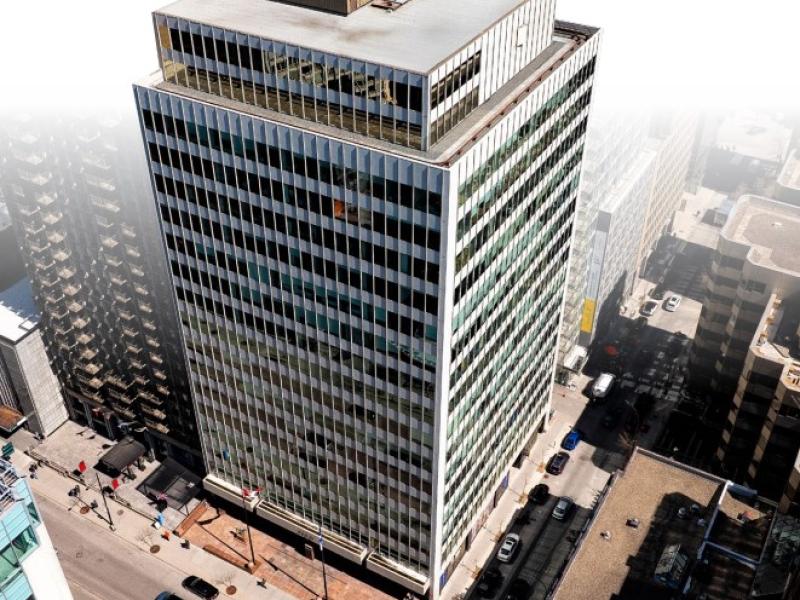
Greg Kwong is the regional managing director for CBRE in Calgary. (Courtesy CBRE)
Is there a glimmer of hope appearing for the struggling downtown office markets in Calgary and Edmonton?
A recent report by CBRE Limited suggests so with some positive news about trends in sublease space in Alberta’s largest cities.
“In recent years, the Canadian real estate market had been somewhat polarized between areas of pronounced strength and areas facing challenges; however, this quarter showed more momentum for cities across the country, including hard-hit Alberta,” said CBRE Canada vice-chairman Paul Morassutti, when the company released its Canada Q1 2019 Quarterly Statistics report national snapshot.
“It’s worth noting that while overall office vacancy has remained stable quarter-over-quarter in Edmonton and Calgary, the amount of sublet space on the market – which serves as a bellwether for the office segment – decreased by 25.1 per cent and 8.6 per cent, respectively. This is a promising indication that Alberta’s CRE conditions look to be improving at long last.”
Key factors in Calgary sublease market
Greg Kwong, regional managing director of CBRE in Calgary, said the reduction of sublease space in the city’s central business district is a combination of that space turning into headlease space, as well as increased leasing activity in the market.
He said much of the sublease space on the market two to three years ago is expiring and rolling into headlease space.
“So, terms are running out and rather than tenants having to sublease the space, they’re just giving the keys back to the landlords and let them worry about it,” said Kwong.
“The second phenomena basically is that a lot of the sublease space has been subleased. That has been really the space where companies have been able to get the most attractive lease terms if they were looking for space within the two, three, four year sublease space. So, a lot of the absorption we’ve experienced for the last little while has been in sublease space. That has diminished the amount as well.”
Edmonton overview
David Young, executive vice-president and managing director at CBRE in Edmonton, said while some sublease space is being rolled into the headlease category, the situation there is a bit different.
“The other key factor is that sublease doesn’t play as important a role as it does, say, in the Calgary market where you’d have oil companies taking massive amounts of space and putting extra space on the market on a regular basis,” said Young.
“There has been some leasing done as well . . . tenants taking advantage of sort of more aggressively priced options in the market.”
Calgary’s downtown office market had just over three million square feet of of sublease space available in the first quarter of this year, which was 26.9 per cent of the vacant downtown office space. Sublease space hit a peak in Calgary in Q2 2017 at just under 4.7 million square feet, which was 39.7 per cent of the total vacant space downtown.
Calgary’s downtown inventory is 42.4 million square feet with a vacancy rate of 26.5 per cent, up slightly from 26.4 per cent in the fourth quarter of 2018.
Tenant mix remains constant
“The profile of the companies taking up the space hasn’t really changed too much in the last six months. It’s really a combination of the oil and gas business, the accountants, law firms and things like that,” said Kwong.
“We haven’t noticed a large group of high-tech companies coming in from Silicon Valley taking 400,000, 500,000 square feet. It’s really more of the existing tenants jostling around.”
Some of the leasing activity has consisted of companies moving from the suburban market to the downtown core to take advantage of lower rental rates.
“We expect the sublease space to stabilize back to normal levels. If you look at most markets across North America, a healthy or stabilized market you see anywhere from 10 to 15 per cent being marketed is sublease space and 85 to 90 per cent being headlease space. That’s kind of a stabilized market in our opinion,” said Kwong.
“We certainly expect it to go back down to those levels over time but the bigger issue is the 26.5 per cent vacancy rate both headlease and sublease. It’s the bigger concern.”
The biggest amount of sublease space in Calgary on the market is just over 500,000 square feet in The Bow building between energy giants Cenovus and Encana.
Tech sector on rise in Edmonton

David Young is executive vice-president and managing director for CBRE in Edmonton. (Courtesy CBRE)
Edmonton’s downtown office market had 375,862 square feet of sublease space available in the first quarter, which is 12.6 per cent of the vacant downtown office space. Sublease space hit a peak in Edmonton in the second quarter of 2017 at 976,269 square feet, which was 29.4 per cent of the total vacant space downtown.
Edmonton’s downtown inventory is 16.2 million square feet with a vacancy rate of 18.4 per cent which is up slightly from 18.2 per cent in the fourth quarter of 2018.
“The leasing of sublease space has come from general financial or insurance and real estate industries. There has been some tech uptake of that space as well. In general, that’s sort of been the lead type of tenants that are taking space in our downtown core. We’ve seen a marked increase in the tech sector,” said Young.
“I’m not saying it’s Vancouver or Toronto, but we’re starting to see the burgeoning of a market that I think will do very well in our downtown core.”
This leads Young to a cautiously optimistic view looking forward.
“I think we’re through the trough in the entire market. I think you’re going to start to see a little bit of growth. Not much, but the worst is behind us in terms of the vacancy.”
Some other report highlights
Among other highlights in the extensive, nationwide report:
* The Toronto office market continues to tighten, dropping to 7.1 per cent overall (down 50 basis points) and just 2.6 per cent in the downtown. The economy created a staggering 50,800 jobs in the quarter. On the industrial side, the picture is even tighter, with vacancy now at 1.5 per cent – the lowest in North America;
* In Vancouver, the industrial sector saw an impressive 1.2 million square feet of absorption in the quarter, dropping the vacancy rate further to 1.9 per cent. The region’s office vacancy also declined, to 4.7 per cent overall and just 2.7 per cent in the downtown (a decline of 110 basis points);
* Montreal’s industrial sector got some relief, with the recent delivery of almost 800,000 square feet of new product easing the vacancy rate up slightly to 3.7 per cent, though net rental rates have hit a record average of $6.01 per square foot. Montreal’s office sector followed the national trend, dropping to 12.2 per cent overall, and 8.6 per cent in the downtown;
* London’s office sector saw its second straight quarter of vacancy declines, dropping 170 basis points to 18.6 per cent. A shuffling of tenants and strong demand in its suburban market led to a dramatic 39.4 per cent increase in asking rental rates to $13.65 per square foot for suburban space;
* In Ottawa, an already tight industrial sector constricted even more, with vacancy declining from 2.7 to 2.2 per cent quarter-over-quarter. No new supply is on the horizon, other than the purpose-built Amazon warehouse in the East End.







